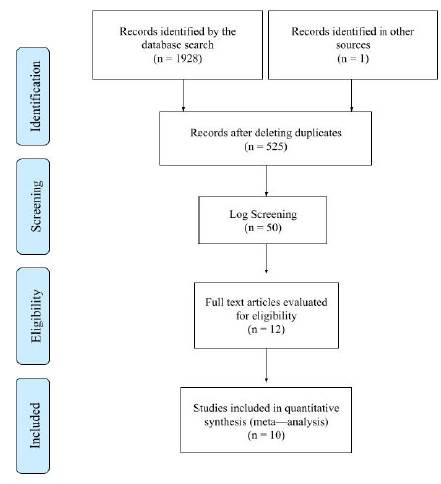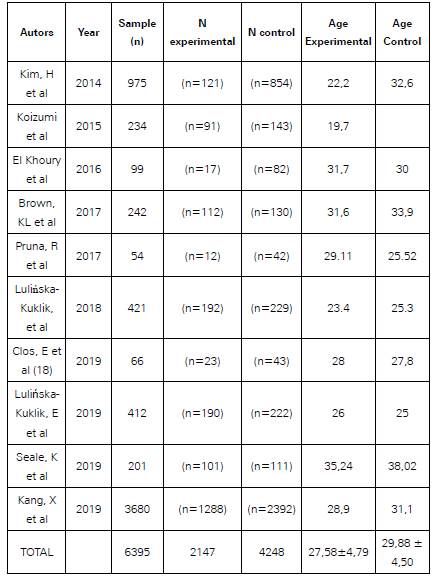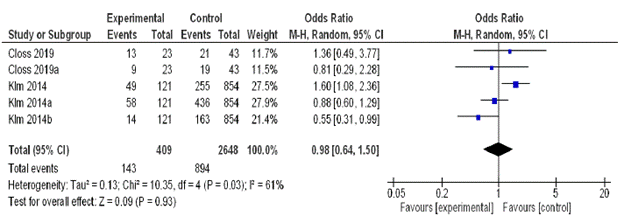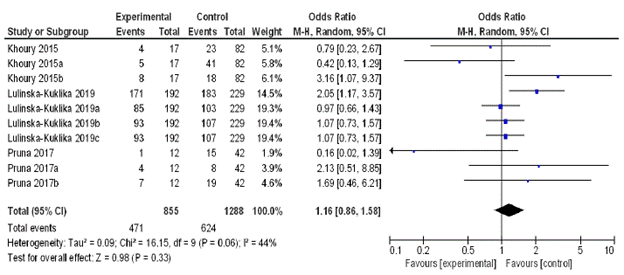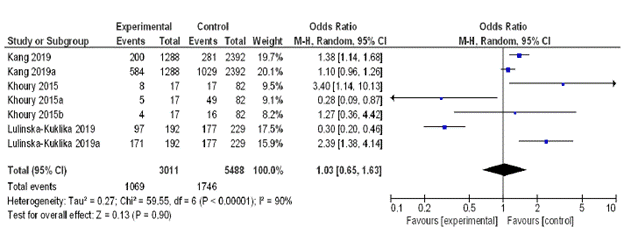Introduction
Since the advances that have been generated with the analysis of the human genome1, various studies propose the explanation of multiple pathologies with the presence of Single Nucleotide Polymorphisms (SNPs), that is why research was sought to link certain SNPs with sports injuries in soccer and, from this, obtain a clear basis for conducting an exploratory study in a population of athletes who presented sports injuries.
Soccer is a group sport in whichplayers require certain physical skills to practice2, This sport manages large investments and a high percentage of people practice it. Soccer is a contact sport and numerous investigations suggest that involved high-intensity movements lead to different injuries3. Understanding that a sports injury is considered:
"Any physical damage that results in pain or discomfort, and that causes one or more conditions during practice : 1) cessation of activity; 2) need to modify the activities usually carried out; 3) negative effects in training or performances; and 4) enough emotional distress that interferes with concentration or focus"4.
Some studies carried out in professional soccer players show an incidence of injury between 70% -78% on all injuries5, which undoubtedly generates a population to be studied. In the same way, Raya-Gonzales et al6 state that players could suffer an injure incidence from 4.40 to 5.8/1,000 hours of play7. fact that the cost of an injured player in the European leagues would represent around 500,000 euros, having him with a disability and representing a high cost for the team .
Undoubtedly, the constant physical exercise in high performance athletes generates adaptations and changes in their physiological functions8, that result in metabolic adjustments, which impact the cardiac and pulmonary systems, among others. At a molecular level, this is evident in the phenotypic changes of soft tissues9, accompanied by the activation or repression of specific signaling in gene expression pathways10, a relevant aspect when identifying the high rate of sports injuries.
Sports injuries depend largely on external and internal factors11, related to vulnerability to these kind of injuries. External factors like the frequency of the exercise, intensity, and workload12 are overcome by designing a tailored routine for the player.
On the other hand, some intrinsic factors are associated with genetic susceptibility13, where several single nucleotide polymorphisms (SNPs) are related. They are located in genes responsible for encoding structural, and soft tissue regulatory proteins that are involved in the lesions14.
Some research refers to genetic markers in relation to some parameters of sports performance15, where the relationship of the SNPs with various pathologies as populations, an example of this are the ACTN genes16, TIMP17, MMP family18 and VEGFA19, a fact that led to the search for relevant information on these genes with sports injuries and which were taken into account for the performance of this meta-analysis.
SNPs contribute to inter-individual variations in the structural and functional properties of muscle and tendon, which could be involved the susceptibility of the lesion20, this is how the literature presents a series of SNPs associated with sports injuries in some genes like ACTN3, a gene that encodes the a-actinin-3 protein, a structural component of the Z disk where the thin filaments of actin are anchored to keep the myofibrillar matrix of fast muscle fibers21. Its absence affects the functionality of skeletal muscle when strong contractions are generated22.
One of the cases presented in recent investigations with athletes of various modalities shows that the SNPs R577 of the ACTN3 gene expresses the substitution of a cytosine (C) for a thymine (T) at nucleotide number 1747 of the DNA sequence in the exon 16, which replaces the synthesis of an arginine with a stop codon23, causing the production of a protein of only 577 amino acids and thus generating two allele variants: a functional R allele and a nonfunctional X allele24.
The iiq22 chromosomal locus harbors a group of MMP genes, several of which have been associated with skeletal muscle lesions25. A functional polymorphism in the MMP8 distribution (collagenase-2) - 799C/T (rsii225395) was involved in skeletal muscle dysfunctions and the T-799 allele demonstrating a relationship with a decrease in the binding of the transcription factor26.
This leads us to review the bibliography related to the association of single nucleotide polymorphisms (SNPs) with sports injuries in soccer. The objective is to strengthen the field of sports genomics, since it has been little explored in Colombia and fundamental for the generation of personalized sports actions, which would give the opportunity to direct preventive actions and timely intervention to lessen the impact of injuries and thus answer the research question about what are the single nucleotide polymorphisms associated with sports injuries in soccer?
Methods and materials
A meta-analysis was carried out, according to the Preferred Reporting Items for Systematic Reviews and Meta- Analyses (PRISMA) guidelines27.
The systematic review of the literature was done until January 2020, there were searched studies published in the last 6 years in the databases indexed in PubMed, ScienceDirect and EBSCO, taking into account that the latest relevant advances in sportomic were present since 201328.
Additional publications were also considered by cross-referencing. Also, a manual search was carried out in the Pubmed databases for the references of the 20 selected articles that served as support for the study.
It was used a combination of keywords to detect potentially relevant studies such as sports injury, muscle strain, muscle damage, sports trauma, sports genetics, soccer injury, polymorphisms or gene or SNPs, and genotype.
Study selection
All publications retrieved were screened by title and any duplicates or those irrelevant to the research question were removed. Abstracts of the remaining studies were then similarly screened and 10 studies were selected for full-text assessment against the predetermined inclusion and exclusion criteria outlined below.
Inclusion and exclusion criteria
The present review included case-control studies and genomic association. To be included, the studies had to provide data on the genotypes associated with the state of the population, whose methodology will perform DNA extraction and quantification. The studies should be written in English or Portuguese with no less than 6 years old since they are the ones that present the most advances in sportomic. There were no restrictions applied regarding the age, gender, or ethnicity of the participants.
Studies were excluded if they were: (i) review articles, congress abstracts, editorials or other non-original articles; (ii) reported in a language other than English. Overall, 14 studies were included for qualitative synthesis. The study selection process and reasons for exclusion are illustrated in Figure 1.
Data extraction and quality assessment
For all selected studies, the following data were extracted: (i) name of first author; (ii) date of publication; (iii) characteristics of the participants; (iv) study design; (v) measured genetic markers; (vi) polymorphisms found and (vii) bias. ( Table 1 )
Risk of bias assessment quality Evaluation
The risk of bias of individual studies was assessed using the Cochrane Collaboration's risk of bias tool29. Studies were given an overall risk of bias grade of either "high", "unclear" or "low" calculated from the following five domains: a) sequence generation, b) allocation concealment, c) blinding, d) Incomplete outcome data, e) selective reporting of results. If details for a particular domain were insufficient, the risk of bias was assessed as "unclear". (Table 2)
Table 2 Assessing risk of bias in included studies.
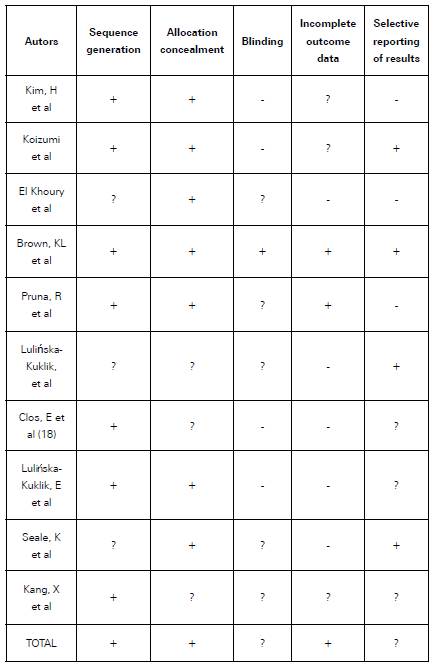
+, low risk of bias; ?, unclear risk of bias; -, high risk of bias.
Source: Authors.
Studies were assessed for inclusion by autors, with disagreements resolved by discussion, and arbitration from the third author if necessary. If a decision on whether to include or exclude a paper could not be made from the title and abstract, the full text was obtained and checked.
Data
For the quality of the studies the Oxford quality scoring system was used30,31.
This scale presents a quality score of five points. Additionally, it includes two criteria for an appropriate randomization method and stealth placement, which range from 0 (weak) to 5 (good) (Table 3).
Table 3 Oxford Quality scoring system.
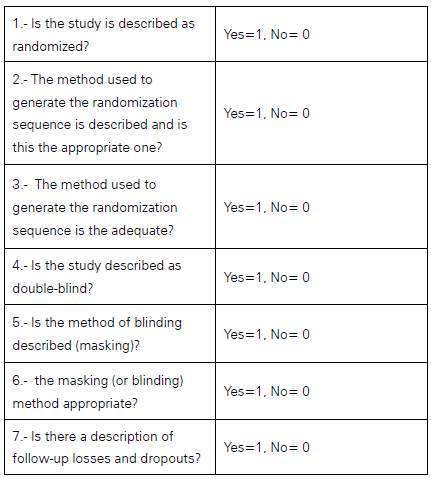
Source: Taken from (Cascaes da Silva, Valdivia Arancibia, da Rosa Iop, Barbosa Gutierres Filho, & da Silva, 2013)
The analyzed studies presented a score of 4.1 points out of 5 was obtained, indicating that the studies have a higher quality than the expected average
Statistical analysis
The random-effects models were used to perform the meta-analysis using the free online software version of Cochrane Review Manager (RevMan) version 5.3. The degree of heterogeneity between the results of the study was evaluated with the statistical I2.
The significant association between polymorphisms and sports injuries in soccer was estimated by odd relationships (OR) at a 95% confidence intervals (CI). The comparison of the soccer players with the controls of the healthy population was made with RevMan to build Forest Plot32.
Results
Once the non-relevant articles were discarded, the PubMed, ScienceDirect, EBSCO databases were used with the cross combination of keywords: sports injury, muscle strain, muscle damage, sports trauma, soccer injury, sports genetics, polymorphisms OR gene OR SNP, genotype. Then, the inclusion criteria were designed as shown in figure 1.
The general characteristics of the 10 studies corresponding to the control and experimental groups are shown in Table 1.
The random-effects model (Odds Ration) was used due to population heterogeneity.
Below is the subgroup analysis performed according to the different polymorphisms found.
The association between ACTN3 polymorphism, and the risk of sports injury is shown in figure 2. It corresponded to the independent studies, finding moderate heterogeneity of 61%, with a negative association (OR = 0.98), 95% CI 0.64 -1.50, and P = 0.93 which is not statistically significant.
The MMP family was associated with the specific polymorphisms MPM3 and MMP8, where the risk of sports injury is shown in figure 3, which corresponded to independent studies. Moderate heterogeneity of 44% was found, the gene family of the study showed a positive association (OR = 1.16) with a 95% CI 0.86-1.58 and a P value = 0.33 that is not significant.
The results show that the TIMP2 gene manifests a significant heterogeneity I2 90%, with an association of risk of injury concerning OR 1.03 indicating a positive association as shown in figure 4.
Another polymorphism found was that corresponding to the VEGFA family, whose heterogeneity is high (I2 of 52%), which leads to a risk of injury of OR 0.98, indicating that the risk of injury is greater in the healthy population, CI of 95% (0.70-1.37), as shown in figure 5.
Discussion
The new sports genomics field focus on research of the SNPs of the genes involved in sports injuries with the aim to evaluate the correlation between a personalized workout with specific SNPs combinations in high performance athletes. This approach is in agreement with Sarzynski MA, Ghosh S, Bouchard33, where it is proposed to establish future training models, design, and plan sports follow-up processes based on the present polymorphisms that have a lower risk34.
The athletic population has a genetic variety being sport an important epigenetic marker for the study29-31. This confirms that the field of sports genetics still lacks some answers and requires more research35. This is explained when physiological responses differ from one individual to another, as well as treatment protocols influence the same heterogeneity of the desired response36. However, this limitation is overcome by expanding research in different sports.
This meta-analysis showed that the population chosen from the different articles is heterogeneous, demonstrating that the presence of certain SNPs affects the risk of sports injury. This is consistent with other similar studies37 where an incidence of SNPs of the ACTN3 R577X gene associated with a hamstring injury affecting flexibility, and at the same time, manifesting limitations in their ranges of joint movement38, for which the presence of this polymorphism would give rise to the increase in muscle-tendon injuries.
Soccer has some modalities where the physical requirements are high39, and for which the presence of an injury is related to whether the athlete has an ACTN3 R577X polymorphism; the foregoing reflects that the risk of injury prevails over the individual who does not manifest it. This is how Miyamoto et al40 infer that this polymorphism is responsible for changes in the sarcomeric cytoskeleton leading to muscle stiffness and prevalence of injury41. One of the limitations found in this study was the diversity of polymorphisms associated with sports injuries as well as the limited availability of research on a gene or a defined polymorphism. For this reason, I2 was very high in contrast to some studies in other areas for treatment42, a situation that differs from the study proposed by Fang et al43 who found significant associations for the alleles of the ACTN3 gene with the different sports disciplines and performance.
The articles showed that the presence of the MMP family specifically, the MMP3, and MMP8 gene does not represent statistical significance contrary to what was stated by Gibbon et al44 where they found a high link with the MMP3 variant associated with a higher risk of injury, but nevertheless the 6A-GCG haplotype45, constructed from the investigated variants, was significantly associated. This leads to the conclusion that the variation in haplotypes determines or not the presence of injury, leading to new research routes. In the same way, it should be noted that the study by Gibbon et al, presented contradictions that were related to the inclusion criteria of the population studied in the present investigation.
As for the MMP8 gene, the study by Lulinska-Kuklik et al46, confirms the low significance of this gene with soft tissue lesions, contrary to what was found by Rahim et al25, where the polymorphism (rs11225395) was implicated in PTT dysfunction: both the TT genotype and T allele were significantly associated with an increased risk of developing tendinopathy. Given this, there is a need for further investigation, since the importance of this gene lies in the degradation of triple helix fibrillar collagen that provides mechanical resistance to tissues47, and affects the stability and solubility properties of collagen. mainly in the ligaments48,49.
The TIMP2 gene has a positive association with sports injuries, but the small sample shows the need to expand it to establish a true association, as stated by Rahim et al50. In fact, in a study with a combined Caucasian cohort (participants from South Africa and Australia)51, it was found that an increase in TIMP expression in tissues such as tendon and ligament, suggests the attempt to regenerate and renew the tissue matrix. Other studies suggest that epigenetic aspects contribute to an alteration of the TIMP2 gene (rs4789932) and its association with the presence of soft tissue injury52.
In the genes observed, it was found that the VEGFA gene was present in studies for sports injuries, since the investigations of Lulinska-Kuklik et al53, associate a possible predisposition to rupture of the anterior cruciate ligament and tendinopathy of Achilles. This is due to the fact that expression levels can be induced by mechanical load, hypoxia and various biochemical factors/molecules, increasing the angiogenic and mitogenic factor54, leading the population to manifest an incidence of sports injuries.
It is also important to highlight the impact of epigenetics, where the environment influences the expression of genes. This is highlighted by Raleigh (2012) (55, when indicating about the implications of epigenetic factors in gene regulation beyond polymorphisms and modification of sports performance. Therefore, robust replication of studies in large cohorts of athletes is required before the findings can be applied to practice in sport.
The limitations of the study are reflected in the limited availability of literature on the subject of sports genomics and its interaction with sports injuries, which is supported by various investigations on the subject56,57.
Although the overall risk of bias within those included studies was considered low, some reports that were excluded had biases due to selective reports and incomplete data. Therefore, it is recommended that future studies include reporting on all measured allele frequencies rather than focusing only on the most common genetic variants.
Conclusions
The meta-analysis allowed us to determine that the field of sports genomics is poorly explored in Colombia and that it requires more research to generate genetic profiles related to sports injuries.
In general, 4 possible SNPs of the different genes that are related to sports injuries in soccer have been identified, which can be used as preliminary evidence to develop an investigation focused on the polygenic nature of complex traits related to specific pathologies of the muscular system and tendinous.
For the MMP and TIMP genes, a positive association was found in relation to sports injuries, while for the ACTN3 and VEGFA genes, a lower risk and negative association were observed.
Statistical significance was found for the TIMP2 (p = 0.0001) and ACTN3 (p = 0.03) genes, which allows generating new horizons from this knowledge, that help to reveal the pathophysiology of sports injuries, not only in soccer but also in other sports.
The Authors declare not to present any conflict of interest and their participation in the entire study process.
Ethical-legal aspects
This study is cataloged as a risk-free investigation by not carrying out any intervention or intentional modification of the biological, physiological, psychological, or social variables of individuals, as stipulated in resolution 8430 of 199358 and following the guidelines of the declaration Helsinki as PRISMA's guide to meta-analysis27.
The present project was approved by the Ethics Committee of the Universidad del Cauca through code 4925 called Sports Injury Prevention.













